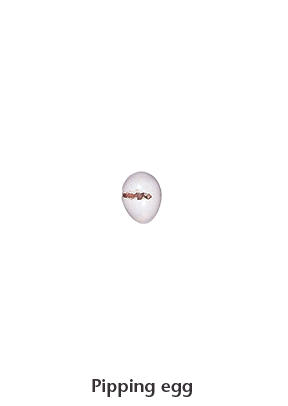It takes just 20 days for a Purple Martin to grow from a tiny hatchling to then reach their peak weight. Nestlings can fledge as early as 26 days, with most fledging around 28-30 days old.
Let’s take a look at each stage of growth of the Purple Martin.

Pipping Egg: If you look at the graphic above carefully, you can see the beak of the hatchling breaking through the shell of its egg. Note that hatching birds break their eggs apart, symmetrically, around the equator.
Hatching Day: Once the nestling has removed the upper cap of its egg, it is ready to free itself from the bottom half. Note that a hatchling martin is totally featherless, its eyelids are grown shut, and its skin is bright pink in color. At hatching, a baby martin will only weigh about 3.0 to 3.5 grams.
3-day old: Note the large, transparent, bellies these young nestlings have. These are their yolk sacs. Although the nestlings are fed by their parents from the moment of hatching, they still acquire nutrition from this embryonic holdover.
5-day old: The nestlings of many cavity-nesting species, such as the Purple Martin, have bright-yellow beak flanges. These function as a highly-visible food target for parent martins as their young gape for food in the darkness of the nest cavity.
6-day old: Feather tracts are beginning to show as darkened blotches under the skin of the nestling, causing the skin to change from an overall pink color to a gray. The eyelid slits begin to partially open.
7-day old: The needlelike sheaths of the flight feathers begin to prick their way out the trailing edge of the wing. They are known as “pin feathers” at this stage.
8-day old: Pin feathers begin to emerge from the fleshy meat of the tail.
10-day old: At this age, the outer primary wing feathers begin to burst their sheaths, as do the tail feathers, exposing emerging, dark-gray feathertips. Note the fluffy, gray feathers beginning to cover the upper flanks of the nestling.
13-day old: Note the speed with which the wing and tail feathers burst their sheaths. The length of these emerging feathers is the best indicator of age in nestling martins.
15-day old: At this age, the pure-white feathers that grow on the upper-middle back become quite apparent.
16-day old: As the feathers burst their disintegrating feather sheaths, the plumage of nestling martins becomes covered with a light-gray, powdery “dandruff.”
20-day old: Martins reach their peak weights at this age, often several grams heavier than their parents. Note the gray neck collar all nestling martins have, regardless of sex.
23-day old: Note how conspicuously martins can display their white flank patches. All ages and sexes of martins have these white patches of feathers. Martins keep them hidden most of the time, but often expose them during preening activities, and possibly at densely-packed nocturnal roosts where it’s hypothesized they use them to communicate the message “I’m perched in this spot – don’t land on me!”
24-day old: Compare this pose with the one the bird had the day before. Today, its white flank feathers are completely covered by the folded wings.
See the original content on the PMCA website.
